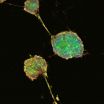(Press-News.org) While a new study led by the University of Colorado Boulder shows the risk of human conflict in East Africa increases somewhat with hotter temperatures and drops a bit with higher precipitation, it concludes that socioeconomic, political and geographic factors play a much more substantial role than climate change.
According to CU-Boulder geography Professor John O'Loughlin, the new CU-Boulder study undertaken with the National Center for Atmospheric Research in Boulder is an attempt to clarify the often-contradictory debate on whether climate change is affecting armed conflicts in Africa. "We wanted to get beyond the specific idea and hype of climate wars," he said. "The idea was to bring together a team perspective to see if changes in rainfall and temperature led to more conflict in vulnerable areas of East Africa."
The research team examined extensive climate datasets from nine countries in East Africa, including the Horn of Africa, between 1990 and 2009: Burundi, Djibouti, Eritrea, Ethiopia, Kenya, Rwanda, Somalia, Tanzania and Uganda. The team also used a dataset containing more than 16,000 violent conflicts in those countries during that time period, parsing out more specific information on conflict location and under what type of political, social, economic and geographic conditions each incident took place.
The study, which included changes in precipitation and temperature over continuous six-month periods from 1949 to 2009, also showed there was no climate effect on East African conflicts during normal and drier precipitation periods or during periods of average and cooler temperatures, said O'Loughlin.
Moderate increases in temperature reduced the risk of conflict slightly after controlling for the influence of social and political conditions, but very hot temperatures increased the risk of conflict, said O'Loughlin. Unusually wet periods also reduced the risk of conflict, according to the new study.
"The relationship between climate change and conflict in East Africa is incredibly complex and varies hugely by country and time period," he said. "The simplistic arguments we hear on both sides are not accurate, especially those by pessimists who talk about 'climate wars'. Compared to social, economic and political factors, climate factors adding to conflict risk are really quite modest."
The results are being published online Oct. 22 in the Proceedings of the National Academy of Sciences. Co-authors on the study include CU-Boulder Research Associate Frank Witmer and graduate student Andrew Linke as well as three scientists from the National Center for Atmospheric research -- Arlene Laing, Andrew Gettelman and Jimy Dudhia. The National Science Foundation funded the study.
Much of the information on the 16,359 violent events in East Africa from 1990 to 2009 came from the Armed Conflict Location and Event Dataset, or ACLED, directed by Clionadh Raleigh of Trinity College in Dublin. The database covers individual conflicts from 1997 to 2009 in Africa, parts of Asia and Haiti – more than 60,000 violent incidents to date. Raleigh started the data collection while earning her doctorate at CU in 2007 under O'Loughlin.
In addition, more than a dozen CU-Boulder undergraduates spent thousands of hours combing online information sources like LexisNexis -- a corporation that pioneered the electronic accessibility of legal and newspaper documents -- in order to fill in details of individual violent conflicts by East African countries from 1990 to 1997. The student work was funded by the NSF's Research Experiences for Undergraduates program.
The CU students coded each conflict event with very specific data, including geographic location coordinates, dates, people and descriptive classifications. The event information was then aggregated into months and into 100-kilometer grid cells that serve as the units of analysis for quantitative modeling.
Each conflict grid also was coded by socioeconomic and political characteristics like ethnic leadership, distance to an international border, capital city, local population size, well-being as measured by infant mortality, the extent of political rights, presidential election activity, road network density, the health of vegetation and crop conditions.
"The effects of climate variability on conflict risk is different in different countries," O'Loughlin said. "Typically conflicts are very local and quite confined. The effects of climate on conflict in Ethiopia, for example, are different than those in Tanzania or Somalia. The idea that there is a general 'African effect' for conflict is wrong."
The researchers used a variety of complex statistical calculations to assess the role of climate in violent conflict in East Africa, including regression models and a technique to uncover nonlinear influences and decrease "noise," said O'Loughlin, also a faculty member at CU-Boulder's Institute of Behavioral Science.
One component of the methods used by the team extracts predictions of individual instances of conflict from the statistical model and systematically compared them with the actual observations of conflict in the data, "a rigorous validity check," he said.
Catastrophic conflicts like those in the "Great Lakes region" -- Rwanda, Burundi, Uganda and the eastern Democratic Republic of the Congo -- since the 1990s and the war with the Lord's Resistance Army led by terrorist Joseph Kony that has been running since the late 1980s in northern Uganda and neighboring regions are marked with large red swaths on the maps.
Legacies of violence are extremely important for understanding and explaining unrest, he said. "Violence nearby and prior violence in the locality, especially for heavily populated areas, are the strongest predictors of conflict."
Ongoing work is extending the study to all of sub-Saharan Africa since 1980 with a database of 63,000 violent events. Preliminary results from the work confirm the East African climate effects of higher than normal temperatures are increasing conflict risk.
###
Contact:
John O'Loughlin, 303-492-1619
Johno@colorado.edu
Jim Scott, CU media relations, 303-492-3114
Jim.Scott@colorado.edu END
Climate variability and conflict risk in East Africa measured by Boulder team
2012-10-23
ELSE PRESS RELEASES FROM THIS DATE:
Evolution of new genes captured
2012-10-23
Like job-seekers searching for a new position, living things sometimes have to pick up a new skill if they are going to succeed. Researchers from the University of California, Davis, and Uppsala University, Sweden, have shown for the first time how living organisms do this.
The observation, published Oct. 19 in the journal Science, closes an important gap in the theory of natural selection.
Scientists have long wondered how living things evolve new functions from a limited set of genes. One popular explanation is that genes duplicate by accident; the duplicate undergoes ...
Rapid changes in the Earth's core: The magnetic field and gravity from a satellite perspective
2012-10-23
Annual to decadal changes in the earth's magnetic field in a region that stretches from the Atlantic to the Indian Ocean have a close relationship with variations of gravity in this area. From this it can be concluded that outer core processes are reflected in gravity data. This is the result presented by a German-French group of geophysicists in the latest issue of PNAS (Proceedings of the National Academy of Sciences of the United States).
The main field of the Earth's magnetic field is generated by flows of liquid iron in the outer core. The Earth's magnetic field protects ...
New Stanford analysis provides fuller picture of human expansion from Africa
2012-10-23
A new, comprehensive review of humans' anthropological and genetic records gives the most up-to-date story of the "Out of Africa" expansion that occurred about 45,000 to 60,000 years ago.
This expansion, detailed by three Stanford geneticists, had a dramatic effect on human genetic diversity, which persists in present-day populations. As a small group of modern humans migrated out of Africa into Eurasia and the Americas, their genetic diversity was substantially reduced.
In studying these migrations, genomic projects haven't fully taken into account the rich archaeological ...
Milky Way's black hole getting ready for snack
2012-10-23
Get ready for a fascinating eating experience in the center of our galaxy.
The event involves a black hole that may devour much of an approaching cloud of dust and gas known as G2.
A supercomputer simulation prepared by two Lab physicists and a former postdoc suggests that some of G2 will survive, although its surviving mass will be torn apart, leaving it with a different shape and questionable fate.
The findings are the work of computational physicist Peter Anninos and astrophysicist Stephen Murray, both of AX division within the Weapons and Complex Integration Directorate ...
New self-healing coating for aluminum developed to replace cancer-causing product
2012-10-23
RENO, Nev. – A research team at the University of Nevada, Reno has developed a new environmentally-friendly coating for aluminum to replace the carcinogenic chromate coatings used in aerospace applications. The chromate conversion coatings have been used for more than 50 years to protect aluminum from corrosion.
The team presented their research last week at the international Pacific Rim Meeting on Electrochemical and Solid-State Science in Hawaii.
"It was well received at the conference," Dev Chidambaram, lead scientist and assistant professor of materials science ...
NASA sees 18th Atlantic depression form
2012-10-23
Tropical Depression 18 (TD18) formed over the southwestern Caribbean Sea at 11 a.m. EDT on Oct. 22, and NASA's TRMM satellite saw a "hot towering" thunderstorm near its center of circulation hinting that it could become a tropical storm soon. A tropical storm watch has been issued for Jamaica.
When NASA's Tropical Rainfall Measuring Mission (TRMM) satellite flew over the developing TD18 early on Oct. 22 at 0040 UTC (Oct. 21 at 8:40 p.m. EDT), the satellite measured rainfall rates within the low pressure area and measured cloud heights of the thunderstorms that make up ...
Additive restores antibiotic effectiveness against MRSA
2012-10-23
Researchers from North Carolina State University have increased the potency of a compound that reactivates antibiotics against methicillin-resistant Staphylococcus aureus (MRSA), an antibiotic-resistant form of Staphylococcus that is notoriously difficult to treat. Their improved compound removes the bacteria's antibiotic resistance and allows the antibiotic to once again become effective at normal dosage levels.
NC State chemist Christian Melander had previously proven the effectiveness of a 2-aminoimidazole compound in reactivating antibiotics against resistant bacterial ...
Crusty foods may worsen heart problems associated with diabetes
2012-10-23
URBANA – A University of Illinois study suggests avoiding cooking methods that produce the kind of crusty bits you'd find on a grilled hamburger, especially if you have diabetes and know you're at increased risk for cardiovascular disease because of your diagnosis.
"We see evidence that cooking methods that create a crust—think the edge of a brownie or the crispy borders of meats prepared at very high temperatures—produce advanced glycation end products (AGEs). And AGEs are associated with plaque formation, the kind we see in cardiovascular disease," said Karen Chapman-Novakofski, ...
New study suggests using sedentary behavior counseling in primary care
2012-10-23
HOUSTON – (Oct. 22, 2012) – Although primary care physicians take care of many aspects of health and disease, little is known about how they can change sedentary behavior through counseling, according to researchers at The University of Texas Health Science Center at Houston (UTHealth). Results from a new study suggest encouraging patients to decrease the time they spend sitting each day may be feasible in the primary care setting.
"Reducing sedentary time can be done by virtually everyone and requires smaller changes in energy expenditure than meeting physical activity ...
Aggressive brain tumors can originate from a range of nervous system cells
2012-10-23
LA JOLLA, CA---- Scientists have long believed that glioblastoma multiforme (GBM), the most aggressive type of primary brain tumor, begins in glial cells that make up supportive tissue in the brain or in neural stem cells. In a paper published October 18 in Science Express, however, researchers at the Salk Institute for Biological Studies have found that the tumors can originate from other types of differentiated cells in the nervous system, including cortical neurons.
GBM is one of the most devastating brain tumors that can affect humans. Despite progress in genetic ...


